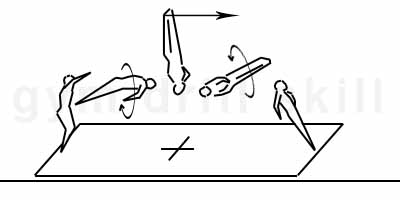


There are several variations of front flip full twist. The skill could begin from a run, front handspring, or in connection after a previous flip. This skill can be done by first assuring that the rotation is adequate, and then executing the twist afterward. The gymnast should rebound upward with the arms raised bent over the shoulders. After the first quarter of the rotation, the turning move should be initiated with the elbow of the leading arm. The arm should cross over the chest with the second arm following in the same direction. The execution of the skill can be performed correctly when the twist starts simultaneously with the rotation. At the moment of the bounce off the floor, the body should be straight and slightly arched from the hips. The twisting should begin after the initial flip rotation has been accomplished. The twisting should begin from the opposite of the rotation hip. During the flight in the second half of the twist, the gymnast should slightly delay the turn from their upper body. The purpose of this is so that they watch the floor and can land arched. The rotation stops when the arms lift away from the chest. At the landing, the athlete could continue with a bounce for another flip or simply land. There are two ways to perform this flip too. At the moment of the bounce, the shoulders can lean up with the body slightly piked from the hips. This allows the flip to become longer and faster. This modification is suitable for flips in connection. In the other scenario, where the front flip twist is the final element of the pass, the gymnast should jump upward in a vertical position during the rotation so that the body is straight and slightly arched.

Run forward and jump from the toes, lift your arms up sideways during the hurdle. At the moment of the bounce with bent arms over the shoulders, lower them shorty in front of the chest almost tight and at the same time lean up slightly in a hollow position from the body. Eyes look straight forward. Jump off and immediately kick back the legs from the heels. During the flight the body should already be slightly arched, the head should be back and the arms should spread to the sides. During the landing, the body transforms into the starting position, ready for the landing, or for rebounding. Doing it this way is optimal for front layouts in connection with other skills, and as a drill for front handsprings on vault. For layouts with twisting, the gymnast should perform a different kind of front layout. Instead of performing a low, long, and fast flip which helps to accelerate tumbling sequences, the gymnast should strive for a higher, potentially slower layout. For this modification of the flip, the arms should remain bent during the take-off and stay over the shoulders. The other difference is that the body should be straight, not leaning forward during the take-off. During the flight, the gymnast should be less arched and more straight. The arms should be bent, close to the body around shoulder height. This will allow the athlete to prepare for twisting.

First, the rotation should be assured from a strong set and kick back with the legs. After the vertical position, before the landing, around the last quarter of the flip, the twist should initiate. With time, the twist should begin earlier and earlier. The gymnast should control the timing.

Bounce off the trampoline, rotate ¾ forward, land on the back and at the following rebound do a half turn with a ¼ rotation. The drill helps to teach the gymnast the timing of the twist.

This drill is the opposite of the back front half on the trampoline. First, the athlete should initiate the ¼ rotation back, bounce off ¾ back with a half twist. This drill emphases on the second half of the full twist. During the twist, the gymnast should keep watching the trampoline.

When the gymnast gets familiar with the first and second half turns, they should start doing them together in one full turn. The easiest way of performing this drill is into the pit, but can be done on the trampoline as well.

The springboard should at the end of the floor, in front of the foam pit. This drill should be performed after a moderate run. The springboard provides the height of the flip, and the pit assures safety in the execution.
Integral part of gymnastics coaching process are skill drills. They help gymnasts to learn easier and technically correct. With GYM DRILL PRO you will find variety of ideas for the most the basic gymnastics skills. There are plenty of images with skill drill progressions. It is intended to support explicitly the qualified coaches in their daily coaching business. DO NOT practice without the guidance of proper professionals.